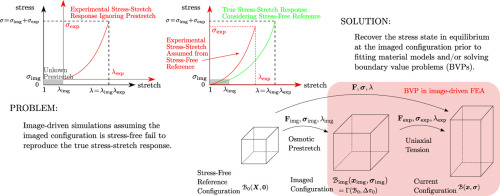Journal of the Mechanical Behavior of Biomedical Materials ( IF 3.3 ) Pub Date : 2018-06-15 , DOI: 10.1016/j.jmbbm.2018.06.014 Xiaogang Wang , Thomas S.E. Eriksson , Tim Ricken , David M. Pierce

|
Medical imaging performed in vivo captures geometries under Donnan osmotic loading, even when the articulating joint is otherwise mechanically unloaded. Hence patient-specific finite element (FE) models constructed from such medical images of cartilage represent osmotically induced prestretched/prestressed states. When applying classical modeling approaches to patient-specific simulations of cartilage a theoretical inconsistency arises: the in-vivo imaged geometry (used to construct the model) is not an unloaded, stress-free reference configuration. Furthermore when fitting nonlinear constitutive models that include osmotic swelling (to obtain material parameters), if one assumes that experimental data–generated from osmotically loaded cartilage–begin from a stress-free reference configuration the fitted stress-stretch relationship (parameters) obtained will actually describe a different behavior. In this study we: (1) establish a practical computational method to include osmotically induced prestretch/prestress in image-driven simulations of cartilage; and (2) investigate the influence of considering the prestretched/prestressed state both when fitting fiber-reinforced, biphasic constitutive models of cartilage that include osmotic swelling and when simulating cartilage responses. Our results highlight the importance of determining the prestretched/prestressed state within cartilage induced by osmotic loading in the imaged configuration prior to solving boundary value problems of interest. With our new constitutive model and modeling methods, we aim to improve the fidelity of FE-based, patient-specific biomechanical simulations of joints and cartilage. Improved simulations can provide medical researchers with new information often unavailable in a clinical setting, information that may contribute to better insight into the pathophysiology of cartilage diseases.
中文翻译:

关于将渗透性预拉伸/预应力结合到图像驱动的软骨有限元模拟中
在体内进行的医学成像可在Donnan渗透负荷下捕获几何形状,即使在关节未受机械负荷的情况下也是如此。因此,从这种软骨的医学图像构建的患者特定的有限元(FE)模型代表了渗透诱导的预拉伸/预应力状态。当将经典的建模方法应用于针对特定患者的软骨模拟时,会出现理论上的不一致:体内成像的几何体(用于构造模型)不是未加载的,没有压力的参考配置。此外,当拟合包括渗透膨胀的非线性本构模型(以获取材料参数)时,如果假设由渗透性软骨产生的实验数据来自无应力参考配置,则获得的拟合应力-拉伸关系(参数)实际上将描述不同的行为。在这项研究中,我们:(1)建立一种实用的计算方法,将渗透诱导的预拉伸/预应力包括在软骨的图像驱动模拟中;(2)研究在拟合纤维增强的包括渗透性肿胀的软骨双相本构模型和模拟软骨反应时考虑预拉伸/预应力状态的影响。我们的结果突出了在解决感兴趣的边界值问题之前,确定成像配置中的渗透负荷所引起的软骨内预拉伸/预应力状态的重要性。借助我们的新本构模型和建模方法,我们旨在提高基于FE的,针对患者的关节和软骨生物力学仿真的逼真度。改进的模拟可以为医学研究人员提供通常在临床环境中不可用的新信息,这些信息可能有助于更好地了解软骨疾病的病理生理学。我们旨在提高基于FE的,针对患者的关节和软骨生物力学仿真的逼真度。改进的模拟可以为医学研究人员提供通常在临床环境中不可用的新信息,这些信息可能有助于更好地了解软骨疾病的病理生理学。我们旨在提高基于FE的,针对患者的关节和软骨生物力学仿真的逼真度。改进的模拟可以为医学研究人员提供通常在临床环境中不可用的新信息,这些信息可能有助于更好地了解软骨疾病的病理生理学。











































 京公网安备 11010802027423号
京公网安备 11010802027423号